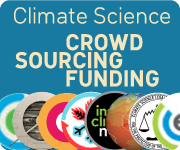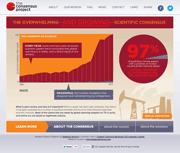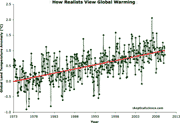Skeptical Science New Research for Week #7 2025
Posted on 13 February 2025 by Doug Bostrom, Marc Kodack
Open access notables
A year above 1.5 °C signals that Earth is most probably within the 20-year period that will reach the Paris Agreement limit, Bevacqua et al., Nature Climate Change:
The temperature goals of the Paris Agreement are measured as 20-year averages exceeding a pre-industrial baseline. The calendar year of 2024 was announced as the first above 1.5 °C relative to pre-industrial levels, but the implications for the corresponding temperature goal are unclear. Here we show that, without very stringent climate mitigation, the first year above 1.5 °C occurs within the first 20-year period with an average warming of 1.5 °C.
Twelve months at 1.5 °C signals earlier than expected breach of Paris Agreement threshold, Cannon, Nature Climate Change:
June 2024 was the twelfth month in a row with global mean surface temperatures at least 1.5 °C above pre-industrial conditions, but it is not clear if this implies a failure to meet the Paris Agreement goal of limiting long-term warming below this threshold. Here we show that in climate model simulations, the long-term Paris Agreement target is usually crossed well before such a string of unusually warm temperatures occurs.
Continued permafrost ecosystem carbon loss under net-zero and negative emissions, Park et al., Science Advances:
The loss of ecosystem carbon (the sum of vegetation, litter, and soil carbon) may occur in a permafrost region under mitigation pathways, which could reduce the efficiency of carbon dioxide removal. Here, we investigate changes in permafrost under net-zero and negative emissions, based on idealized emission-driven simulations using a state-of-the-art Earth system model. While acting as a net ecosystem carbon sink during most of the positive emission phase, permafrost becomes a net ecosystem carbon source just before reaching net-zero and negative emissions. Permafrost slowly recovers, especially in regions with high organic carbon content, and net ecosystem carbon loss persists until the end of simulations, resulting in a cumulative net ecosystem carbon loss of approximately 14 petagrams of carbon (PgC) in both scenarios. In addition, methane emissions increase under net-zero and negative emissions, due to the irreversibility of the inundated areas. We conclude that the permafrost ecosystem carbon loss may continue under net-zero and negative emissions, which could hinder climate change mitigation efforts.
Airspace restrictions due to conflicts increased global aviation’s carbon dioxide emissions in 2023, Dannet et al., Communications Earth & Environment:
As air traffic rebounds from its large drop during the Covid-19 crisis, civil aviation needs to continue addressing its climate impact. Knowledge of aircraft trajectories is essential for an accurate assessment of the CO2 (and non-CO2) climate impact of aviation. Here we combine an aircraft trajectory optimization algorithm and a global database of aircraft movements to quantify the impact of airspace restrictions due to conflict zones on CO2 emissions. Among current restrictions, we show that the Russian ban of its airspace to Western airlines following the invasion of Ukraine has the largest impact. Our analysis reveals an initial reduction of flights to and from East Asia that would have crossed the Russian territory. Routes then gradually reopened by making a detour, which led to an average increase in fuel consumption of 13% on the affected routes, with a greater impact for flights to and from Europe (14.8%) compared to flights to and from North America (9.8%). Although these flights represent only a small fraction of the daily flights, the large detours have increased global aviation CO2 emissions by 1% in 2023, equivalent to a quarter of the yet-to-be-achieved efficiency gain potential from improved air traffic management.
Interactions Between Climate Mean and Variability Drive Future Agroecosystem Vulnerability, Sinha et al., Global Change Biology:
Agriculture is crucial for global food supply and dominates the Earth's land surface. It is unknown, however, how slow but relentless changes in climate mean state, versus random extreme conditions arising from changing variability, will affect agroecosystems' carbon fluxes, energy fluxes, and crop production. We used an advanced weather generator to partition changes in mean climate state versus variability for both temperature and precipitation, producing forcing data to drive factorial-design simulations of US Midwest agricultural regions in the Energy Exascale Earth System Model. We found that an increase in temperature mean lowers stored carbon, plant productivity, and crop yield, and tends to convert agroecosystems from a carbon sink to a source, as expected; it also can cause local to regional cooling in the earth system model through its effects on the Bowen Ratio. The combined effect of mean and variability changes on carbon fluxes and pools was nonlinear, that is, greater than each individual case. For instance, gross primary production reduces by 9%, 1%, and 13% due to change in mean temperature, change in temperature variability, and change in both temperature mean and variability, respectively. Overall, the scenario with change in both temperature and precipitation means leads to the largest reduction in carbon fluxes (−16% gross primary production), carbon pools (−35% vegetation carbon), and crop yields (−33% and −22% median reduction in yield for corn and soybean, respectively).
How will we prepare for an uncertain future? The value of open data and code for unborn generations facing climate change, Gomes, Proceedings of the Royal Society B: Biological Sciences
As the impacts of climate change continue to intensify, humans face new challenges to long-term survival. Humans will likely be battling these problems long after 2100, when many climate projections currently end. A more forward-thinking view on our science and its direction may help better prepare for the future of our species. Researchers may consider datasets the basic units of knowledge, whose preservation is arguably more important than the articles that are written about them. Storing data and code in long-term repositories offers insurance against our uncertain future. To ensure open data are useful, data must be FAIR (Findable, Accessible, Interoperable and Reusable) and be complete with all appropriate metadata. By embracing open science practices, contemporary scientists give the future of humanity the information to make better decisions, save time and other valuable resources, and increase global equity as access to information is made free. This, in turn, could enable and inspire a diversity of solutions, to the benefit of many. Imagine the collective science conducted, the models built, and the questions answered if all of the data researchers have collectively gathered were organized and immediately accessible and usable by everyone. Investing in open science today may ensure a brighter future for unborn generations.
From this week's government/NGO section:
Carbon Capture, Usage, and Storage, Committee of Public Accounts, House of Commons, United Kingdom
The Department for Energy Security and Net Zero (the Department) considers carbon capture, use, and storage (CCUS) as essential for the UK to meet its net-zero targets. In introducing its current CCUS program, it has learned lessons from two previous failed attempts. Progress in introducing the new program has been slow. The Department will need to find alternative ways of reducing emissions if there are further delays in agreeing support for more projects, or if the technology’s performance is not as good as it expects. If the projects are successful, the Department has not considered how it could maximize the financial benefits for taxpayers and consumers. The Department will need to revisit its value–for–money case for supporting CCUS regularly, taking account of changes in the scientific understanding of carbon capture and storage and the impact this may have on the assumptions underpinning its program.
Climate Obstruction. The State and Spread of Climate Disinformation in Canada, Solomun et al., The Centre for Media, Technology, and Democracy
While climate denial historically defined opposition to climate action, the discourse is increasingly shifting into new territory online: climate delayism. These delay tactics leverage discourses that accept the existence of climate change, but downplay its urgency and sow doubt in potential solutions. What’s more, the rapid spread of mis- and disinformation online—and platforms’ inability and recent overt unwillingness to regulate it has supercharged these climate delay narratives. But climate disinformation is not just a social media problem. It operates through a complex and historically situated network of powerful actors with vested interests and is woven into the fabric of Canadian nationhood and identity itself. We need to understand how climate delay and disinformation narratives circulate and find resonance in our broader information ecosystem. To that end, the authors analyze Canadians’ response to prominent climate delay narratives and presents key findings and policy implications for the burgeoning problem of climate disinformation in Canada.
127 articles in 55 journals by 843 contributing authors
Physical science of climate change, effects
Can the Marked Arctic Ocean Freshwater Content Increases of the Last Two Decades Be Explained Within Observational Uncertainty?, Le Bras & Timmermans, Journal of Geophysical Research: Oceans 10.1029/2024jc021061
Deciphering the role of evapotranspiration in declining relative humidity trends over land, Kim & Johnson Johnson, Communications Earth & Environment Open Access 10.1038/s43247-025-02076-9
Long-term variations in pH in coastal waters along the Korean Peninsula, Lee et al., Biogeosciences Open Access 10.5194/bg-22-675-2025
Observed multi-decadal increase in the surface ocean’s thermal inertia, Lee et al., Nature Climate Change Open Access pdf 10.1038/s41558-025-02245-w
When Simplification Leads to Ambiguity: A Look at Two Ocean Metrics for the Subpolar North Atlantic, Chafik & Lozier, Geophysical Research Letters Open Access 10.1029/2024gl112496
Observations of climate change, effects
A 40-year remote sensing analysis of spatiotemporal temperature and rainfall patterns in Senegal, Nakalembe et al., Open Access pdf 10.31223/x55x21
A year above 1.5 °C signals that Earth is most probably within the 20-year period that will reach the Paris Agreement limit, Bevacqua et al., Nature Climate Change Open Access 10.1038/s41558-025-02246-9
Human-induced climate change increased 2021-2022 drought severity in Horn of Africa, Kimutai et al., Weather and Climate Extremes Open Access 10.1016/j.wace.2025.100745
Remarkable 2023 North Atlantic Ocean Warming, Carton et al., Geophysical Research Letters Open Access 10.1029/2024gl112551
Instrumentation & observational methods of climate change, effects
A new machine-learning based cloud mask using harmonized data of two Meteosat generations shows a general decrease in cloudiness over Europe in recent decades, Gaurav et al., Remote Sensing of Environment Open Access 10.1016/j.rse.2025.114599
Comparative analysis of bias correction methods for projecting extreme precipitation and temeprature indices in Pakistan, Ali et al., Atmospheric Research 10.1016/j.atmosres.2025.107957
Modeling, simulation & projection of climate change, effects
Compound Climate Extremes Under the Future Climate Change Scenarios: A Case Study of Chattogram City, Bangladesh, Pervin et al., International Journal of Climatology 10.1002/joc.8772
Continued permafrost ecosystem carbon loss under net-zero and negative emissions, Park et al., Science Advances 10.1126/sciadv.adn8819
Future projections of climate variables and meteorological drought: Insight from CMIP6 models in Southeast Ethiopia, Tadase & Tekile, Dynamics of Atmospheres and Oceans 10.1016/j.dynatmoce.2025.101538
Lake energy balance response to 21st century warming in the tropical high Andes, Sae-Lim et al., Global and Planetary Change 10.1016/j.gloplacha.2025.104741
Projected changes in wind speed and wind energy resources over the Persian Gulf based on bias corrected CMIP6 models, Gohari & Akp?nar Akp?nar Akpinar, Dynamics of Atmospheres and Oceans Open Access pdf 10.1016/j.dynatmoce.2025.101539
Twelve months at 1.5 °C signals earlier than expected breach of Paris Agreement threshold, Cannon, Nature Climate Change Open Access 10.1038/s41558-025-02247-8
Advancement of climate & climate effects modeling, simulation & projection
AMOC Variability in Climate Models and Its Dependence on the Mean State, Ferster et al., Geophysical Research Letters Open Access 10.1029/2024gl110356
An improved and extended parameterization of the CO2 15 µm cooling in the middle and upper atmosphere (CO2&cool&fort-1.0), López-Puertas et al., Geoscientific Model Development Open Access 10.5194/gmd-17-4401-2024
Convection-permitting climate simulations over South America: Experimentation during different phases of ENSO, Liu et al., Atmospheric Research 10.1016/j.atmosres.2025.107936
Convectively Coupled Global Rossby Modes in an Idealized Moist GCM, MacDonald et al., Journal of the Atmospheric Sciences Open Access 10.1175/jas-d-24-0081.1
Design, evaluation and future projections of the NARCliM2.0 CORDEX-CMIP6 Australasia regional climate ensemble, Di Virgilio et al., Geoscientific Model Development Open Access 10.5194/gmd-18-671-2025
Design, evaluation, and future projections of the NARCliM2.0 CORDEX-CMIP6 Australasia regional climate ensemble, Di Virgilio et al., Geoscientific Model Development Open Access 10.5194/gmd-18-671-2025
Evaluation of CORDEX ERA5-forced NARCliM2.0 regional climate models over Australia using the Weather Research and Forecasting (WRF) model version 4.1.2, Di Virgilio et al., Geoscientific Model Development Open Access 10.5194/gmd-18-703-2025
Evaluation of CORDEX ERA5-forced ‘NARCliM2.0’ regional climate models over Australia using the Weather Research and Forecasting (WRF) model version 4.1.2, Di Virgilio et al., Geoscientific Model Development Open Access 10.5194/gmd-18-703-2025
Improved Representations of Longwave Surface Emissivity to Reduce Surface and Atmospheric Heating Biases in Earth System Models, Manzo et al., Journal of Geophysical Research: Atmospheres Open Access 10.1029/2024jd041776
Improving vertical detail in simulated temperature and humidity data using machine learning, da Silva Rodrigues & Morcrette, Atmospheric Science Letters Open Access 10.1002/asl.1288
Cryosphere & climate change
Antarctica in 2025: Drivers of deep uncertainty in projected ice loss, Fricker et al., Science 10.1126/science.adt9619
Comparing Surface Mass Balance and Surface Temperatures From Regional Climate Models and Reanalyses to Observations Over the Antarctic Ice Sheet, Wang et al., International Journal of Climatology Open Access 10.1002/joc.8767
Physically based modelling of glacier evolution under climate change in the tropical Andes, Mackay et al., The Cryosphere Open Access 10.5194/tc-19-685-2025
The Future of Snowstorms in Central and Eastern North America, Ashley et al., International Journal of Climatology 10.1002/joc.8770
Sea level & climate change
The Eastern Mediterranean Sea mean sea level decadal slowdown: the effects of the water budget, Borile et al., Frontiers in Climate Open Access 10.3389/fclim.2025.1472731
Paleoclimate & paleogeochemistry
Ocean warming, icebergs, and productivity in the Gulf of Alaska during the Last Interglacial, Sánchez Montes et al., Frontiers in Earth Science Open Access 10.3389/feart.2024.1485521
Paleoclimate proxy records suggest reduced tropical Pacific zonal asymmetry under sustained global warming, Chung et al., Communications Earth & Environment Open Access 10.1038/s43247-025-02039-0
Biology & climate change, related geochemistry
Climate-induced range expansion of cushion plants promotes functional homogenization of soil nematode communities, Zhang et al., Ecology 10.1002/ecy.70017
Effect of Diet Changes in Benthic Ecosystems owing to Climate Change on the Physiological Responses of Turbo sazae in Waters around Jeju Island, Korea, Ryu et al., Marine Environmental Research Open Access 10.1016/j.marenvres.2025.107001
Effects of Climate Warming on the Performance of Gynaephora alpherakii (Lepidoptera: Lymantriidae) Larvae in a Tibetan Alpine Meadow, Cao et al., Ecology and Evolution Open Access 10.1002/ece3.70978
Herbivory resistance in dwarf shrubs combines with simulated warming to shift phenology and decrease reproduction, Gillespie & Hegland Stein Joar Hegland Stein Joar Hegland, Journal of Ecology Open Access 10.1111/1365-2745.14462
Light competition affects how tree growth and survival respond to climate, Beauchamp et al., Journal of Ecology Open Access 10.1111/1365-2745.14489
Model sensitivity limits attribution of greenhouse gas emissions to polar bear demographic rates, Wilson & Andersen, Scientific Reports Open Access 10.1038/s41598-025-89218-3
Navigating Climate Change: Exploring the Dynamics Between Plant–Soil Microbiomes and Their Impact on Plant Growth and Productivity, Muhammad et al., Global Change Biology 10.1111/gcb.70057
Physiological and Molecular Responses of Tropical Seagrass Enhalus acoroides Exposed to Simultaneous High Temperature and Hypoxia Stress, Li et al., Marine Environmental Research 10.1016/j.marenvres.2025.106997
Thalassia hemprichii may benefit from ocean acidification and slightly increased salinity in the future, Shi et al., Marine Environmental Research 10.1016/j.marenvres.2025.107000
The effect of temperature on carbon, nitrogen elements, and chlorophyll-a content in harmful algal blooms and their role in marine carbon and nitrogen cycles, Wen et al., Marine Environmental Research 10.1016/j.marenvres.2025.106978
Understanding the long-term dynamics of vegetation since 1953 in high-mountain regions, Ramskogler et al., Journal of Ecology Open Access 10.1111/1365-2745.14472
Vulnerability of benthic trait diversity across the Mediterranean Sea following mass mortality events, Carlot et al., Nature Communications Open Access 10.1038/s41467-025-55949-0
GHG sources & sinks, flux, related geochemistry
A New Framework for the Attribution of Air-Sea CO2 Exchange, Ito & Reinhard, Open Access 10.22541/essoar.172526717.75361102/v1
Airspace restrictions due to conflicts increased global aviation’s carbon dioxide emissions in 2023, Dannet et al., Communications Earth & Environment Open Access 10.1038/s43247-024-01956-w
Changes in leaf and root carbon allocation of global vegetation simulated by the optimally integrated ecosystem models, Duanmu et al., Agricultural and Forest Meteorology 10.1016/j.agrformet.2024.110366
Diverse Altitudinal Patterns and Drivers of Greenhouse Gas Dynamics in Southwest China Alpine Streams and Rivers, Wang et al., Journal of Geophysical Research: Biogeosciences 10.1029/2024jg008458
Impacts of Spartina alterniflora invasion on coastal carbon cycling within a native Phragmites australis-dominated wetland, Huang et al., Agricultural and Forest Meteorology 10.1016/j.agrformet.2025.110405
Increased in local precipitation weakenes long-term responses of soil carbon and nitrogen to climate change: Insights from a 37-year experiment, Zhou et al., Global and Planetary Change 10.1016/j.gloplacha.2025.104745
Plant species richness mediates the responses of microbial necromass carbon accumulation to climate aridity in alpine meadows, Mou et al., Journal of Ecology 10.1111/1365-2745.70008
Precipitation trends cause large uncertainties in grassland carbon budgets—a global meta-analysis, Cui et al., Agricultural and Forest Meteorology 10.1016/j.agrformet.2025.110432
Proglacial methane emissions driven by meltwater and groundwater flushing in a high-Arctic glacial catchment, Kleber et al., Biogeosciences Open Access 10.5194/bg-22-659-2025
Regulation of desiccation-immersion cycle on the rate and fate of dissolved organic carbon release by Ulva pertusa, Wang et al., Marine Environmental Research 10.1016/j.marenvres.2024.106943
Research Status and Development Trend of Greenhouse Gas in Wetlands: A Bibliometric Visualization Analysis, Zhu et al., Ecology and Evolution Open Access 10.1002/ece3.70938
Soil Moisture Threshold of Methane Uptake in Alpine Grassland Ecosystems, Wang et al., Global Change Biology 10.1111/gcb.70062
Spatial and temporal variations of gross primary production simulated by land surface model BCC&AVIM2.0, Li et al., Advances in Climate Change Research Open Access 10.1016/j.accre.2023.02.001
Using new geospatial data and 2020 fossil fuel methane emissions for the Global Fuel Exploitation Inventory (GFEI) v3, Scarpelli et al., Open Access 10.5194/essd-2024-552
Variability in storm season intensity modulates ocean acidification conditions in the northern Strait of Georgia, Evans et al., Scientific Reports Open Access 10.1038/s41598-025-88241-8
Wildfires mediate carbon transfer from land to lakes across boreal and temperate regions, Bélair et al., Communications Earth & Environment Open Access 10.1038/s43247-025-02070-1
CO2 capture, sequestration science & engineering
Accounting for retarded weathering products in comparing methods for quantifying carbon dioxide removal in a short-term enhanced weathering study, te Pas et al., Frontiers in Climate Open Access 10.3389/fclim.2024.1524998
Calcite is an efficient and low-cost material to enhance benthic weathering in shelf sediments of the Baltic Sea, Fuhr et al., Communications Earth & Environment Open Access 10.1038/s43247-025-02079-6
Carbon sequestration in different urban vegetation types in Southern Finland, Thölix et al., Biogeosciences Open Access 10.5194/bg-22-725-2025
Establishing leadership in bringing carbon capture, utilisation and storage to scale, El Farsaoui et al., Energy Research & Social Science Open Access 10.1016/j.erss.2025.103960
How to govern carbon dioxide removal: an assessment framework for policy instruments, Holland-Cunz & Baatz, Climate Policy Open Access 10.1080/14693062.2025.2459315
Multi-agent simulation of policies driving CCS technology in the cement industry, Yu et al., Energy Policy 10.1016/j.enpol.2025.114527
Multiple planetary boundaries preclude biomass crops for carbon capture and storage outside of agricultural areas, Braun et al., Communications Earth & Environment Open Access 10.1038/s43247-025-02033-6
Regional Resource Evaluation and Distribution for Onshore Carbon Dioxide Storage and Utilization in Uzbekistan, Kamolov et al., Greenhouse Gases: Science and Technology Open Access pdf 10.1002/ghg.2325
Seawater carbonate chemistry based carbon dioxide removal: towards commonly agreed principles for carbon monitoring, reporting, and verification, Halloran et al., Frontiers in Climate Open Access 10.3389/fclim.2025.1487138
Geoengineering climate
Global carbonate chemistry gradients reveal a negative feedback on ocean alkalinity enhancement, Lehmann & Bach, Nature Geoscience 10.1038/s41561-025-01644-0
Maize Yield Changes Under Sulfate Aerosol Climate Intervention Using Three Global Gridded Crop Models, Clark et al., Earth's Future Open Access 10.1029/2024ef005269
World Climate Research Programme lighthouse activity: an assessment of major research gaps in solar radiation modification research, Haywood et al., Frontiers in Climate Open Access 10.3389/fclim.2025.1507479
Aerosols
Development of a hybrid algorithm for the simultaneous retrieval of aerosol optical thickness and fine-mode fraction from multispectral satellite observation combining radiative transfer and transfer learning approaches, Tang et al., Remote Sensing of Environment Open Access 10.1016/j.rse.2025.114619
Climate change communications & cognition
A value-based topography of climate change beliefs and behaviors, Karimi-Malekabadi et al., Open Access 10.31234/osf.io/umqbp
Climate Information Exposure on Social Media and Climate-Related Political Participation: The Mediating Roles of Environmental Discussion and Risk Perception, Zhang, Environmental Communication 10.1080/17524032.2025.2464150
Climate Polarization on Czech Social Media After Trump’s Announcement to Withdraw the US from the Paris Agreement, Svozil et al., Environmental Communication Open Access 10.1080/17524032.2025.2456230
Climate Solutions and Climate Attribution in Extreme Heat Press Coverage: The July 2022 UK Heatwaves, Hopke & Wozniak, Environmental Communication Open Access 10.1080/17524032.2025.2458219
Populist Frames in Climate Discourse: How Right-Wing Politics Rewrites the Narrative on Climate Change, Rahmadi et al., Environmental Communication 10.1080/17524032.2025.2462989
When ‘no point’ becomes a turning point: the role of culture, economy, and climate impacts on environmental sacrifice, Doyle, Environmental Sociology Open Access 10.1080/23251042.2025.2461164
Who views what from whom? Social media exposure and the Chinese public's risk perceptions of climate change, Huang & Bu, Risk Analysis 10.1111/risa.17716
Agronomy, animal husbundry, food production & climate change
A collaborative climate vulnerability assessment of California marine fishery species, Frawley et al., PLOS Climate Open Access 10.1371/journal.pclm.0000574
Carbon benefits through agroforestry transitions on unmanaged fallow agricultural land in Hawai?i, Bremer et al., Scientific Reports Open Access 10.1038/s41598-025-87891-y
Carbon finance for forest resilience in California, Elias et al., Frontiers in Forests and Global Change Open Access 10.3389/ffgc.2024.1507554
Farmers’ adaptation strategies to climate change on agricultural production in Arsi zone, Oromia National Regional State of Ethiopia, Dawid & Boka, Frontiers in Climate Open Access 10.3389/fclim.2025.1447783
Forestry, from theory to practice: Central European ideas in native Patagonian forests in a context of climate change, Bava & Caselli, Frontiers in Forests and Global Change Open Access 10.3389/ffgc.2025.1377026
Impact of 38-year integrated nutrient management on soil carbon sequestration and greenhouse gas emissions of a rice-wheat cropping system, Kaur et al., Agricultural and Forest Meteorology 10.1016/j.agrformet.2025.110415
Impact of climate change over distribution and potential range of chestnut in the Iberian Peninsula, Álvarez-Álvarez et al., Frontiers in Forests and Global Change Open Access 10.3389/ffgc.2025.1561027
Interactions Between Climate Mean and Variability Drive Future Agroecosystem Vulnerability, Sinha et al., Global Change Biology Open Access 10.1111/gcb.70064
Low perception of climate change by farmers and herders on Tibetan Plateau, Yi et al., Global Environmental Change Open Access 10.1016/j.gloenvcha.2025.102970
Modeling biochar effects on soil organic carbon on croplands in a microbial decomposition model (MIMICS-BC&v1.0), Han et al., Geoscientific Model Development Open Access 10.5194/gmd-17-4871-2024
Seasonal vapor pressure deficit and temperature effects on carbon dioxide and water dynamics in a prevalent crop rotation in the northern Great Plains, Whippo et al., Agricultural and Forest Meteorology 10.1016/j.agrformet.2025.110425
The impact of sky conditions on gross primary production and methane flux from different rice paddies, Zhu et al., Atmospheric Environment 10.1016/j.atmosenv.2025.121098
Turning Up the Heat: More Persistent Precipitation Regimes Weaken the Micro-Climate Buffering Capacity of Forage Grasses During a Hot Summer, Reynaert et al., Global Change Biology 10.1111/gcb.70078
Hydrology, hydrometeorology & climate change
Hotspots of Global Water Resource Changes and Their Causes, Lu et al., Earth's Future Open Access 10.1029/2024ef005461
Precipitation- and Temperature-Driven Future Changes to Flooding in Alaska, Michalek et al., Geophysical Research Letters Open Access 10.1029/2024gl112004
Climate change economics
Evaluating institutional climate finance barriers in selected SADC countries, Pillay et al., Climate Risk Management Open Access 10.1016/j.crm.2025.100694
Climate change and the circular economy
Rapid vehicle electrification reduces carbon benefits but increases resource savings in circular automobile transitions, He et al., Environmental Research: Infrastructure and Sustainability Open Access 10.1088/2634-4505/adaf52
Climate change mitigation public policy research
Applying equity principles leads to higher carbon removal obligations in Canada, Motlaghzadeh et al., Communications Earth & Environment Open Access 10.1038/s43247-025-02080-z
Competing values, ideologies and lock-in dependencies in sociotechnical pathways for industrial decarbonization, Sovacool et al., Environmental Science & Policy Open Access 10.1016/j.envsci.2025.104017
Do local parties only mind their own business? Explaining the deployment of large-scale solar energy projects in Germany, ?etkovi? & Bertemes, Energy Research & Social Science 10.1016/j.erss.2025.103968
Expert views on the legitimacy of renewable hydrogen certification schemes, Goodwin et al., Energy Research & Social Science Open Access 10.1016/j.erss.2025.103970
From framing to implementation: The experience of local sustainability administration in the US, Bick, Environmental Science & Policy Open Access 10.1016/j.envsci.2025.104003
From skyscrapers to sky savers: how New York City’s Local Law 97 advances climate resilience and public health, Chervonski et al., Frontiers in Climate Open Access 10.3389/fclim.2025.1537130
Lack of harmonisation of greenhouse gases reporting standards and the methane emissions gap, Cenci & Biffis Biffis, Nature Communications Open Access 10.1038/s41467-025-56845-3
Modeling renewable energy market performance under climate policy uncertainty: A novel multivariate quantile causality analysis, Sinha et al., Risk Analysis 10.1111/risa.17714
Presidential agendas without success: United States critical minerals and materials policy to support the electric vehicle transition, Hua et al., Energy Research & Social Science 10.1016/j.erss.2025.103964
The acceleration of low-carbon transitions: Insights, concepts, challenges, and new directions for research, Sovacool et al., Energy Research & Social Science Open Access 10.1016/j.erss.2025.103948
The politics of renewable energy transition in Ghana: Issues, obstacles and prospects, Tettey et al., Energy Research & Social Science 10.1016/j.erss.2025.103939
Unions, fossil fuel workers, and the energy transition: learning from plant closures in Finland and the U.S., Lempinen et al., Climate Policy Open Access 10.1080/14693062.2025.2460665
Climate change adaptation & adaptation public policy research
Diverging equity implications of FEMA disaster aid received by counties in Gulf coast states, Kalafatis et al., Climate Risk Management Open Access 10.1016/j.crm.2024.100659
Enhancing climate change-induced flood co-adaptation in the Johor river basin, Malaysia: A dotmocracy mapping approach with key technical stakeholders, Sa’adi et al., Environmental Science & Policy 10.1016/j.envsci.2025.104015
Finding mobility in place attachment research: lessons for managed retreat, Willcocks-Musselman et al., Frontiers in Climate Open Access 10.3389/fclim.2025.1514408
Non-linear spectral unmixing for monitoring rapidly salinizing coastal landscapes, Sarupria et al., Remote Sensing of Environment 10.1016/j.rse.2025.114642
The value of structured expert judgment to help assess climate adaptation, Magnan et al., Climate Risk Management Open Access 10.1016/j.crm.2025.100692
Climate change impacts on human health
Consequences of climate change on human health and performance and mitigation strategies in Brazil, Wanner et al., Temperature 10.1080/23328940.2025.2459997
Disentangling climate’s dual role in dengue dynamics: A multiregion causal analysis study, Cawiding et al., Science Advances 10.1126/sciadv.adq1901
Exposed Population to Temperature Extremes in MENA in the Context of Paris Climate Agreement Temperature Goals, Hamed et al., International Journal of Climatology 10.1002/joc.8778
Intersecting Memories of Immunity and Climate: Potential Multiyear Impacts of the El Niño–Southern Oscillation on Infectious Disease Spread, Chung et al., GeoHealth Open Access 10.1029/2024gh001193
[Review] The public health co-benefits of strategies consistent with net-zero emissions: a systematic review, Moutet et al., The Lancet Planetary Health Open Access 10.1016/s2542-5196(24)00330-9
Other
Moving beyond post hoc explainable artificial intelligence: a perspective paper on lessons learned from dynamical climate modeling, O'Loughlin et al., Geoscientific Model Development Open Access 10.5194/gmd-18-787-2025
Social remittances and the environment in the context of climate change: What do we know? Where do we go?, Diniega & Sakdapolrak, Climate and Development Open Access 10.1080/17565529.2024.2449121
Informed opinion, nudges & major initiatives
Data injustice and attribution of drought events: implications for global climate policy, Fezzigna et al., Climate Policy Open Access 10.1080/14693062.2025.2462633
Generative AI exacerbates the climate crisis, Chen et al., Science Open Access 10.1126/science.adt5536
Habitability for a connected, unequal and changing world, Sterly et al., Global Environmental Change Open Access 10.1016/j.gloenvcha.2024.102953
How will we prepare for an uncertain future? The value of open data and code for unborn generations facing climate change, Gomes, Proceedings of the Royal Society B: Biological Sciences Open Access 10.1098/rspb.2024.1515
Increasing Hydroclimatic Whiplash Can Amplify Wildfire Risk in a Warming Climate, Swain et al., Global Change Biology 10.1111/gcb.70075
Articles/Reports from Agencies and Non-Governmental Organizations Addressing Aspects of Climate Change
Close to home. How to build more housing in a changing climate, Ness et al., Canadian Climate Institute
In communities across Canada, the race is on to build millions of new homes as quickly as possible to improve housing affordability. While the speed of construction is important, it is also essential to consider where homes will be built. With climate change driving more frequent and severe extreme weather and weather-related hazards, building homes in safe locations is essential—because the most affordable home is one that does not have to be rebuilt after a disaster. To meet housing affordability targets, an estimated 5.8 million homes need to be built by 2030—a 35 percent increase to Canada’s existing housing stock. But if existing policies do not change, hundreds of thousands of these new homes will be built in areas at risk from floods and wildfires, putting Canadians in harm’s way and costing billions of dollars every year. The authors show how Canada can meet its housing needs while keeping people safe in a changing climate. It is the first of its kind in Canada to quantify the economic risks of building new homes in the paths of wildfires and floods.
Repurposing the United Nations to Address the Climate Crisis on the Tibetan Plateau, Mark Cogan, Institute for Security and Development Policy
The ability of the United Nations to adapt to changing humanitarian, security, human rights, and development conditions at all levels remains a critical challenge, as China has also asserted itself with the bureaucracies of UN agencies, organs, and among member-states around the globe. To respond to climate-related challenges on the Tibetan Plateau, attainable, realistic reforms and strategies must be implemented to repurpose the UN. For example, UN agencies must move beyond organizational designs and strategies that involve “siloed” or one dimensional thinking. Rather, climate change must become part and parcel of the development process from initial inputs to final outcomes.
Climate Change, International Migration and Self-Determination: Lessons From Tuvalu, Carol Farbotko, Toda Peace Institute
The author examines two international migration pathways for Tuvaluans: one forthcoming and one proposed, for how well they align with Tuvalu’s goal of ensuring Tuvaluan self-determination and sovereignty in-situ. Climate change poses a habitability risk to Tuvalu associated with sea-level rise, A forthcoming migration pathway, between Tuvalu and Australia under the new Tuvalu-Australia Falepili Union Treaty is partially in harmony with Tuvaluan sovereignty. The second, the suggestion by Rising Nations Initiative to relocate the entire national population of Tuvalu does not harmonise well with the goal of maintaining Tuvaluan sovereignty in place.
Redefining Horizons: International Tribunal for the Law of the Sea Advisory Opinion on Climate Obligations, Nishant Sirohi, Observer Research Foundation
The 2024 advisory opinion issued by the International Tribunal for the Law of the Sea (ITLOS), recognizing GHG emissions as marine pollution, marks a pivotal intersection in maritime and climate governance. The opinion, while non-binding, establishes legal obligations for states to mitigate climate-induced marine impacts, including acidification, warming, and sea-level rise. It emphasizes due diligence, transboundary impact assessments, and adherence to the principle of ‘common but differentiated responsibilities’. The opinion holds important implications for developing states, presenting both challenges and opportunities to align sustainability goals with climate commitments. By bridging the UN Convention on the Law of the Sea and broader climate frameworks like the Paris Agreement, ITLOS advances international legal norms and sets a precedent for future climate litigation. The author analyses these implications, focusing on India and other Global South nations.
Carbon Capture, Usage, and Storage, Committee of Public Accounts, House of Commons, United Kingdom
The Department for Energy Security and Net Zero (the Department) considers carbon capture, use, and storage (CCUS) as essential for the UK to meet its net-zero targets. In introducing its current CCUS program, it has learned lessons from two previous failed attempts. Progress in introducing the new program has been slow. The Department will need to find alternative ways of reducing emissions if there are further delays in agreeing support for more projects, or if the technology’s performance is not as good as it expects. If the projects are successful, the Department has not considered how it could maximize the financial benefits for taxpayers and consumers. The Department will need to revisit its value–for–money case for supporting CCUS regularly, taking account of changes in the scientific understanding of carbon capture and storage and the impact this may have on the assumptions underpinning its program.
Solar Power and Environmental Peacebuilding in South-central Somalia, Ann-Sophie Böhle and Kheira Tarif, Stockholm International Peace Research Institute
In Somalia, widespread energy poverty and a heavy reliance on conventional energy sources are deeply linked to ongoing conflict dynamics. Dependence on firewood and charcoal worsens environmental degradation and intensifies competition over natural resources. These challenges are further exacerbated by the effects of climate change and limited access to basic services. To address these interconnected challenges, the International Organization for Migration (IOM) in Somalia is advancing rural electrification through solar power as part of a broader environmental peacebuilding strategy. The authors explore how the IOM’s approach to solar power and the facilitation of local public-private partnerships (PPPs) can support environmental peacebuilding at three levels: the community level, the local business level, and the district council level. By creating local PPP agreements to implement solar power projects, the initiatives aim to foster cooperation, reduce resource-based tensions, and strengthen government legitimacy in south-central Somalia.
Rethinking Load Growth: Assessing the Potential for Integration of Large Flexible Loads in US Power Systems, Norris et al, Nicholas Institute for Energy, Environment and Sustainability, Duke University
A key solution to the United States soaring electrical demand—driven by unprecedented electricity needs from data centers and their booming artificial intelligence workloads, alongside other consumers—is load flexibility. Flexibility allows large electricity users to temporarily reduce consumption during periods of grid stress by shifting workloads, using on-site generation, or adjusting operations. By leveraging flexibility, new large loads can be interconnected more quickly while reducing the need for premature investment in additional power plants and transmission lines—offering a hedge against uncertainty in future electricity demand in light of the release of DeepSeek. This first-of-its-kind, national-scale analysis provides a first-order estimate of how much new flexible load could be added across the 22 largest US balancing authorities, which collectively serve 95% of the grid. The authors introduce a new concept—curtailment-enabled headroom—to describe how much additional load the grid can absorb using existing capacity, with only modest, short-duration reductions in use. The findings highlight a significant opportunity: nearly 100 GW of large new loads could be integrated with minimal impact, supporting economic growth while maintaining grid reliability and affordability.
Climate Obstruction. The State and Spread of Climate Disinformation in Canada, Solomun et al., The Centre for Media, Technology, and Democracy
While climate denial historically defined opposition to climate action, the discourse is increasingly shifting into new territory online: climate delayism. These delay tactics leverage discourses that accept the existence of climate change, but downplay its urgency and sow doubt in potential solutions. What’s more, the rapid spread of mis- and disinformation online—and platforms’ inability and recent overt unwillingness to regulate it has supercharged these climate delay narratives. But climate disinformation is not just a social media problem. It operates through a complex and historically situated network of powerful actors with vested interests and is woven into the fabric of Canadian nationhood and identity itself. We need to understand how climate delay and disinformation narratives circulate and find resonance in our broader information ecosystem. To that end, the authors analyze Canadians’ response to prominent climate delay narratives and presents key findings and policy implications for the burgeoning problem of climate disinformation in Canada.
Wind and solar year in review 2024, Diren Kocaku?ak, Global Energy Monitor
Prospective utility-scale solar and wind capacity — projects that have been announced or are in the pre-construction and construction phases — grew by over 20% globally in 2024 from 3.6 terawatts (TW) to 4.4 TW, only half of what is needed for global tripling renewable goals. Outside of China and the Group of 7 (G7) rich nations, only half of solar and wind projects designated to come online in 2024 were actually completed on time. Global operating capacity increased by 14% in 2024, as at least 240 gigawatts (GW) of utility-scale solar and wind came online. Despite their 45% share of global gross domestic product (GDP), G7 countries are building only 10% of planned solar and wind projects.
Obtaining articles without journal subscriptions
We know it's frustrating that many articles we cite here are not free to read. One-off paid access fees are generally astronomically priced, suitable for such as "On a Heuristic Point of View Concerning the Production and Transformation of Light" but not as a gamble on unknowns. With a median world income of US$ 9,373, for most of us US$ 42 is significant money to wager on an article's relevance and importance.
- Here's an excellent collection of tips and techniques for obtaining articles, legally.
- Unpaywall offers a browser extension for Chrome and Firefox that automatically indicates when an article is freely accessible and provides immediate access without further trouble. Unpaywall is also unscammy, works well, is itself offered free to use. The organizers (a legitimate nonprofit) report about a 50% success rate
- The weekly New Research catch is checked against the Unpaywall database with accessible items being flagged. Especially for just-published articles this mechansim may fail. If you're interested in an article title and it is not listed here as "open access," be sure to check the link anyway.
How is New Research assembled?
Most articles appearing here are found via RSS feeds from journal publishers, filtered by search terms to produce raw output for assessment of relevance.
Relevant articles are then queried against the Unpaywall database, to identify open access articles and expose useful metadata for articles appearing in the database.
The objective of New Research isn't to cast a tinge on scientific results, to color readers' impressions. Hence candidate articles are assessed via two metrics only:
- Was an article deemed of sufficient merit by a team of journal editors and peer reviewers? The fact of journal RSS output assigns a "yes" to this automatically.
- Is an article relevant to the topic of anthropogenic climate change? Due to filter overlap with other publication topics of inquiry, of a typical week's 550 or so input articles about 1/4 of RSS output makes the cut.
A few journals offer public access to "preprint" versions of articles for which the review process is not yet complete. For some key journals this all the mention we'll see in RSS feeds, so we include such items in New Research. These are flagged as "preprint."
The section "Informed opinion, nudges & major initiatives" includes some items that are not scientific research per se but fall instead into the category of "perspectives," observations of implications of research findings, areas needing attention, etc.
Suggestions
Please let us know if you're aware of an article you think may be of interest for Skeptical Science research news, or if we've missed something that may be important. Send your input to Skeptical Science via our contact form.
Journals covered
A list of journals we cover may be found here. We welcome pointers to omissions, new journals etc.
Previous edition
The previous edition of Skeptical Science New Research may be found here.































 Arguments
Arguments






























Comments